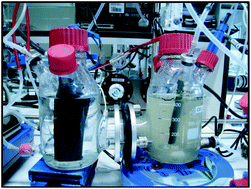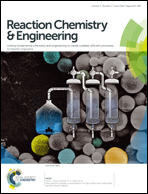Impact of dissolved carbon dioxide concentration on the process parameters during its conversion to acetate through microbial electrosynthesis†
Abstract
The reduction of carbon dioxide (CO2) released from industry can help to reduce the emissions of greenhouse gases (GHGs) to the atmosphere while at the same time producing value-added chemicals and contributing to carbon fixation. Microbial electrosynthesis (MES) is a recently developed process which accomplishes this idea by using cathodic bacteria at the expense of only minimum energy. In this study, enriched mixed homoacetogenic bacteria as cathodic biocatalysts for the reduction of CO2 with five different concentrations were evaluated to produce acetate at a constant potential. Increasing the carbon concentration showed an improved acetate production rate and carbon conversion efficiency. A maximum acetate production rate of 142.2 mg L per day and a maximum carbon conversion efficiency of 84% were achieved, respectively, at 4.0 and 2.5 g HCO3− L−1. The changes in pH due to interactive reactions between the bicarbonate (substrate) and acetate (products) were able to create a buffering nature in the catholyte controlling the operating parameters of the MES process, such as pH and substrate specificity. A higher acetate production shifted the catholyte pH toward acidic conditions, which further triggered favorable conditions for the bioelectrochemical reduction of acetate to ethanol.

- This article is part of the themed collection: Industry R&D collection


 Please wait while we load your content...
Please wait while we load your content...